The Contemporary Buttercream Bible (36 page)
Read The Contemporary Buttercream Bible Online
Authors: Christina Ong Valeri Valeriano

buttercreams in an individual piping bag and cut a
hole at the tip. Starting from the edge of the cake
and working downwards, with steady pressure on
your
piping
bag,
pipe
medium
size
counter-clockwise loops with spaces in the middle,
making sure that each loop is overlapping (B).
413
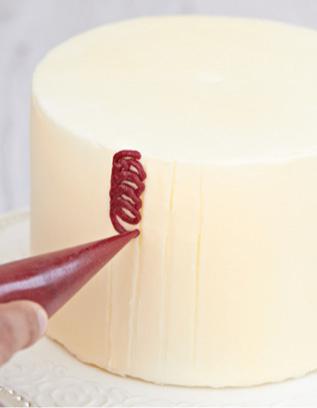
B
3 Repeat the same process to create the next
vertical line of clockwise crochet stitches (C).
Continue until the stitches cover the whole cake.
You can change the colour to add variety.
414
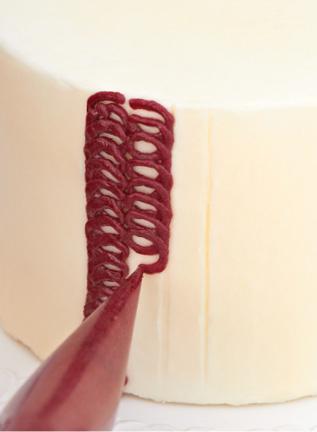
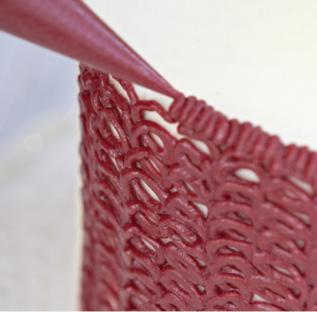
C
4 To finish off the top edge of the cake, pipe a
crochet line as described in the first variation
crochet tutorial (D).
415
D
Tip
Because the whole cake is very textured do
not add too many floral embellishments, as
you want to focus more on the crochet design
rather than the flowers.
416
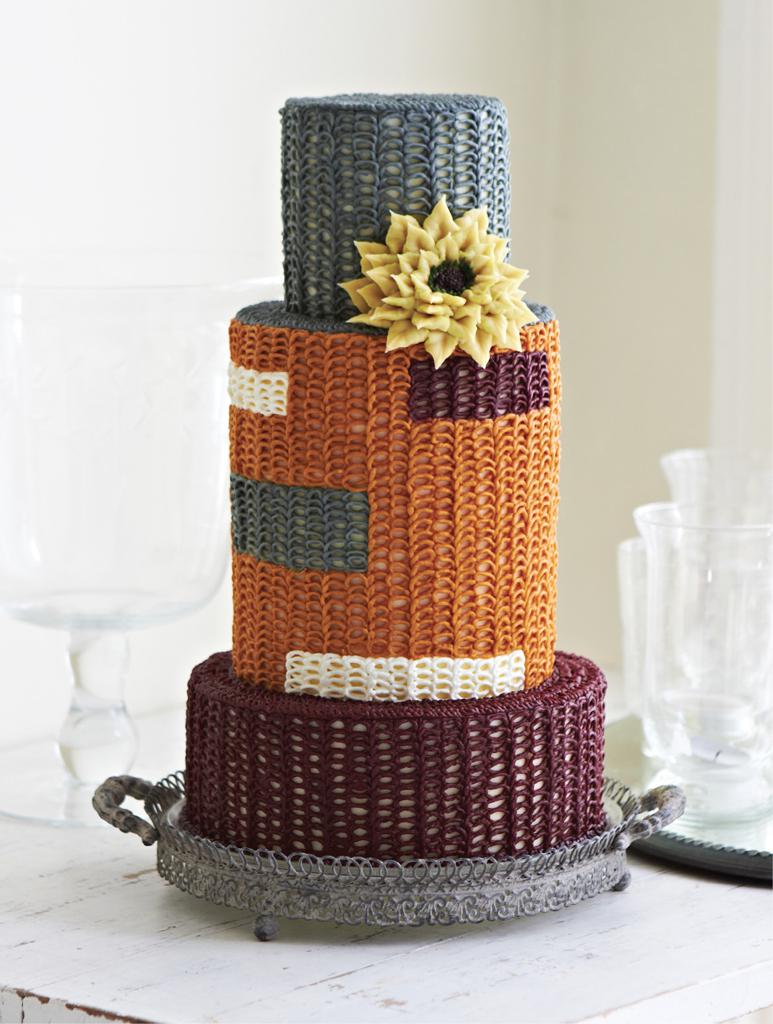
To create this cake…
• 20 × 10cm (8 × 4in) round cake (bottom tier), 15
× 18cm (6 × 7in) round cake (middle tier), 10 ×
10cm (4 × 4in) round cake (top tier)
• 2.8–3.5kg (6lb 4oz–7lb 11oz) buttercream
417
• Dowel rods
• Paste colours: biege (Sugarflair Caramel), green
(Sugarflair Gooseberry), brown (Sugarflair Dark
Brown), burgundy (Sugarflair Burgundy), grey
(Sugarflair Liquorice), white (Sugarflair Super
White), dark yellow (Sugarflair Autumn Leaf)
• Scraper or ruler
• Piping bags
• Scissors
• Leaf nozzle (Wilton 352)
• Cake stand or covered cake board
Crumb coat, dowel and stack the cakes (see
Buttercream Basics) and place on a stand or
covered board. Cover and smooth the cakes using
900g–1kg (2lb–2lb 4oz) of plain buttercream (see
Covering Cakes in Buttercream Basics). Colour the
remaining buttercream in the following quantities:
200–300g (7–101⁄ oz) beige, 100–200g (31
2
⁄2–7oz)
each of green and brown, 600–700g (1lb 5oz–1lb
9oz) burgundy, 150–200g (51⁄2–7oz) grey, 50–100g
(13⁄ –31
4
⁄2oz) white and 700–800g (1lb 9oz–1lb 12oz)
dark yellow. Refer to the photograph and follow the
tutorial to pipe the crochet in dark yellow,
418
burgundy, grey and white. Finish the top edge of
each cake and the bottom with a row of crochet
following the first variation tutorial. Pipe a
sunflower at the base of the top tier with beige
buttercream (see Sunflower and Leaves in Piping
Flowers), and complete its centre with dots of green
and brown.
419
Writing
Think of a personalized cake given your own special
touch with a heartfelt written message – you’d love
to be able to do it, but you’re worried that you’ll
ruin your otherwise beautifully decorated cake. Of
all the skills to master, piped writing seems to be
the most daunting. But never fear! We have lots of
suggestions to help. You can learn to pipe the words
freestyle or with a little help from some small tools
– ideal for those whose handwriting suffers from
artistic shortcomings (or is nearly illegible).
420
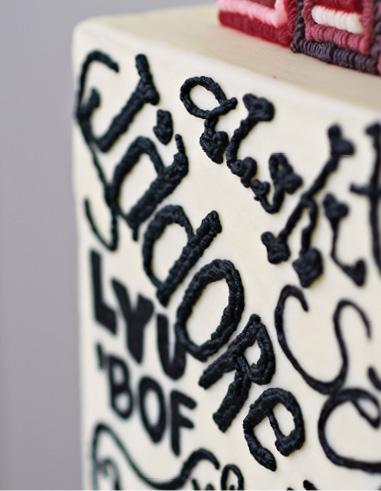
421
Direct Piping
This approach is for those who scribble confidently
and write legibly. With this technique, you will
write the words by directly piping the buttercream
on to the cake. Given the right grip and proper
pressure on the piping bag, you will be able to
achieve perfect handwriting.
EFFECTS OF NOZZLES
In the column below we used five different kinds of
nozzles to write one word – LOVE – but this is just
a fraction of the range of nozzles that you can use.
You can see that on changing the nozzle, the overall
effect of the word will change, giving different
character to the cake.
422
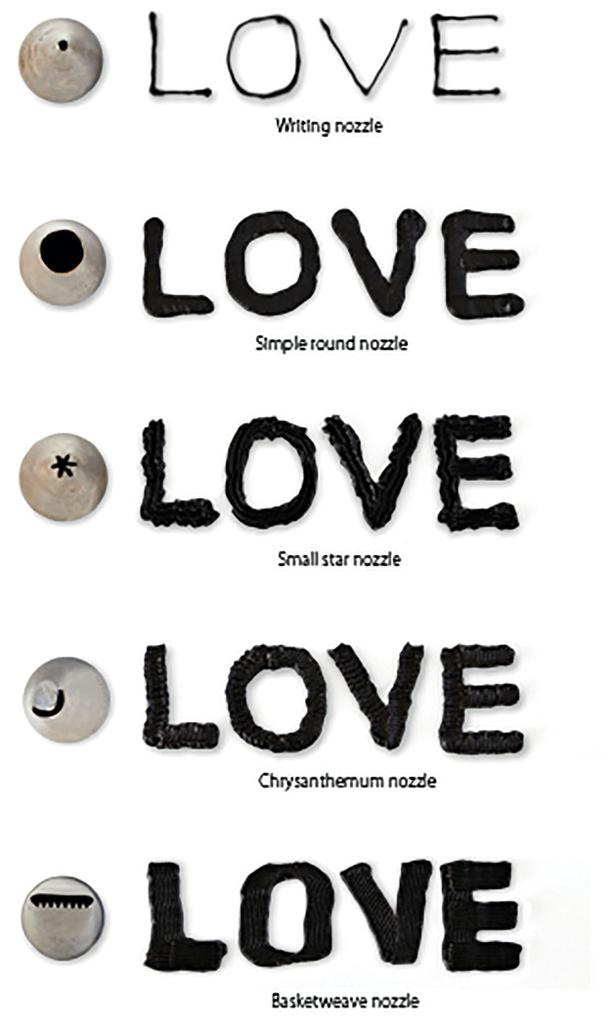
423
DIFFERENT WRITING STYLES
Below we have also shown just a few of the many
styles of writing that you might want to use. Again,
the style you choose will have an effect on the
overall impression the cake gives – from zany to
romantic. All the examples in the column below
were piped with a writing nozzle.
424
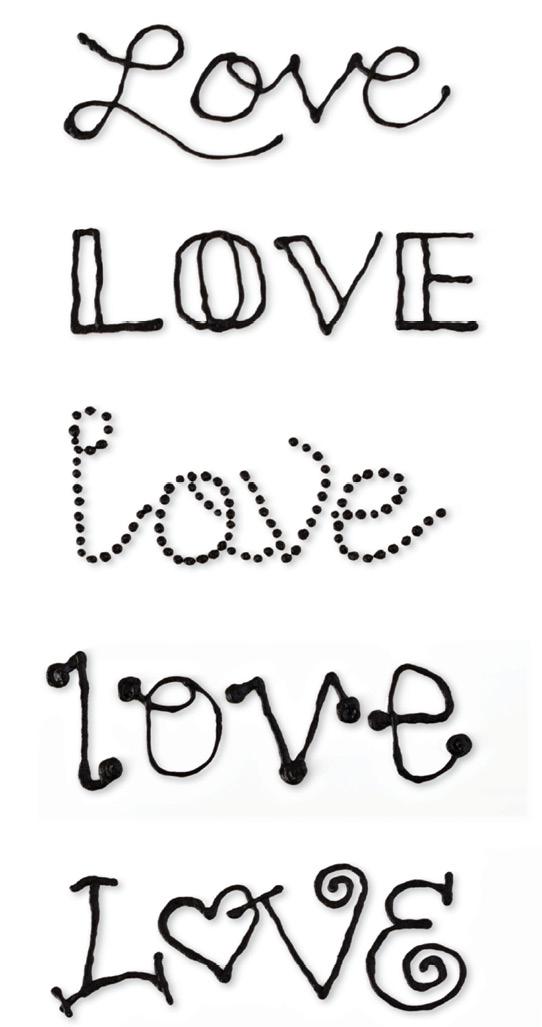
425
You will need…
• Buttercream
• Piping bags
• Scissors
• Writing nozzle 0-3 (optional)
You can either use a writing nozzle or just cut a
small hole at the tip of your piping bag to write your words. When you write, make sure that the tip of
your nozzle or your piping bag lightly touches the
surface of your cake so that the buttercream does
not curl. Ideally, hold your piping bag straight and
make sure you squeeze it with even pressure, from
the beginning of a word to the end, so the thickness
will be the same throughout. It is also helpful to rest your wrist very gently on the corner of the cake or
use your other hand to support your dominant hand
while writing, so it is not too shaky. It is a good idea to use a cocktail stick (toothpick) to mark the
surface of the cake with a couple of dots to show
yourself where to start and finish, or use the pattern transfer technique (see Pattern Transfer).
426
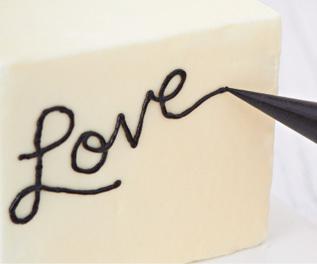
Tip
Another trick for better freehand writing that we
use is to measure the width of the space
where we are going to write and draft the
words on paper first. Then we can check that
the words will fit into that space before we pipe
on the cake.
Painting
This technique can be both easy and tricky at the
same time. Easy because the writing tool is a
paintbrush, which means you will have enough
tolerance to outline, paint and then go back over to
improve your handwriting. But it can be tricky
